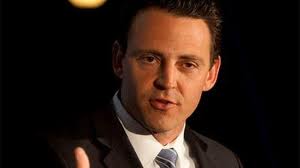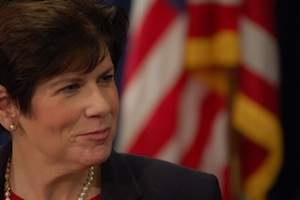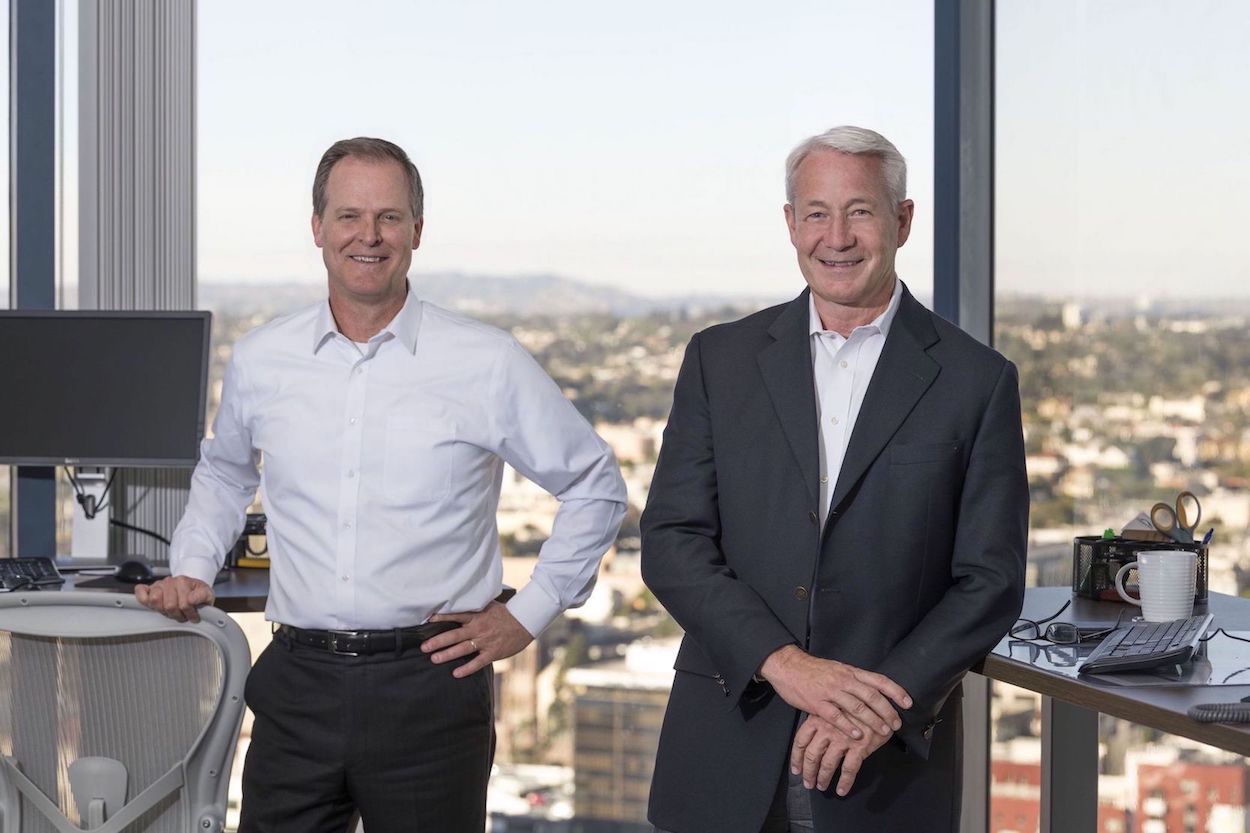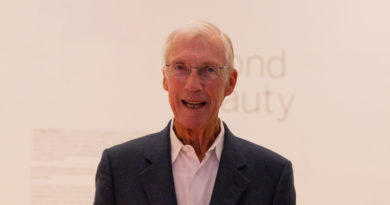Cover Story — DeMaio vs. Filner
DeMAIO vs. FILNER
By eschewing the traditional moderates, San Diegans have set up a rare partisan battle in the November mayor election
By Liam Dillon | Voice of San Diego
Illustration by Jason Luper (www.starkwhitestudios.com)
Change of the kind not seen in decades is coming to San Diego City Hall.
When Republican City Councilman Carl DeMaio and Democratic Congressman Bob Filner advanced to the mayoral runoff in June, it set up a partisan fight San Diegans aren’t used to seeing when they pick their leader.
“What we have had really in the entire post-World War II era has been center-right and center-slightly left mayors,” said Steve Erie, a UC San Diego professor who wrote a recent book on the city’s political history. “They don’t fit the pattern.”
DeMaio and Filner defeated the two other candidates who did fit the pattern. Assemblyman Nathan Fletcher, whose Republican-turned-independent bid in March was the race’s biggest surprise, lost ground throughout election night. Republican District Attorney Bonnie Dumanis, who had courted the same moderate support as Fletcher and backed it up with nearly 40 years of history in San Diego government, never caught fire during the campaign.
The success of DeMaio and Filner sets up a monumental clash between two politicians rarely victorious in city politics: anti-Downtown partisans. Even more their temperaments, which tend toward confrontation rather than consensus, make them outliers. If current Mayor Jerry Sanders reminds you of your kindly uncle, then DeMaio and Filner are your cranky cousins.
Despite DeMaio and Filner’s difference from the San Diego norm, it looked like Fletcher and Dumanis were done in by forces larger than themselves. Voter turnout appeared anemic. And primary voters tend to be more partisan. The endorsed candidates of the Republican and Democratic parties both advanced.
On its own, this simple calculation could explain Filner’s success on Election Day. He’s a long-time liberal who has a 30-year history in San Diego politics. The 69-year-old was the only Democrat in the race and these bona fides carried him through despite a lackluster campaign. He was able to hold off a furious fight from Fletcher, who courted interest groups as diverse as bike advocates and dog owners.
DeMaio, who has seemed like he was running for mayor since he first arrived in San Diego a decade ago, led the race from start to finish.
“San Diegans have been clear,” DeMaio said in his victory speech at the U.S. Grant Hotel. “They don’t want business as usual at City Hall anymore.”
The Move to the Middle
The success of DeMaio and Filner means they’ll have to do the opposite of what made them winners on primary night. They have to court San Diego voters in the middle who aren’t used to this kind of mayor’s race.
DeMaio’s already telegraphed his next steps. He’s announced his pivoting from pensions to potholes, a prime issue in a city notorious for its rough roads and one that doesn’t discriminate between Republicans and Democrats. His victory speech touched on themes he’s never made a big deal out of before: education, renewable energy, clean water, beaches, bays and open space.
“Reform in San Diego has no party label,” he said. “It’s a San Diego cause.”
DeMaio also could try to find moderate support through his backing of the $520 million proposed Convention Center expansion. Despite his anti-tax persona, DeMaio has championed a big hotel room tax hike to pay for it, something Filner opposes. The project has the major backing of the city’s powerful tourism and Downtown business lobbies, and DeMaio can make the case that only he can deliver.
Meanwhile, Filner could go after jobs and education. he could draw a contrast with DeMaio’s slash-city-fees-and-burn-city-regulations economic development plan and reposition the issue as a fight for middle-class jobs. Filner also could use his college teaching background and time on the school board to take the lead on schools. It’s one big issue DeMaio doesn’t have a plan to fix.
DeMaio’s Two-Year Mayoral Bid
The seeds of DeMaio’s first place finish were laid almost two years ago when the councilman had his greatest political failure. He had spent $450,000 and six months on a dramatic outsourcing initiative designed to be the big issue for the November 2010 election. It imploded. DeMaio collected too many duplicate signatures and it didn’t make the ballot. This collapse fed the most damaging criticism against DeMaio: he could throw bombs, but not lead.
But talks between the city political power players about DeMaio’s measure turned into the first serious discussions about a sales tax hike once DeMaio’s effort failed. The tax increase made the ballot. DeMaio found a new cause. He became its most outspoken and energetic opponent and danced on its grave when it lost by almost 25 points.
Three days after the tax hike failed, DeMaio used his momentum to begin his mayoral campaign. He released the financial plan that’s become the foundation of his bid for the mayor’s office. The plan included a proposal to give most new city workers 401(k)-style retirements, instead of guaranteed pensions. He brokered a deal with Mayor Sanders, who also wanted to eliminate pensions, for a new ballot measure.
DeMaio made the initiative, Proposition B, synonymous with his campaign. The measure’s popularity and Republican support forced Fletcher and Dumanis eventually to endorse it and even Filner couldn’t escape it on the trail. DeMaio’s yard signs had “Carl DeMaio For Mayor” on top and “Yes on B: Pension Reform!” on bottom. Prop. B won on primarly election night, passing by more than 32 points.
DeMaio’s success happened as part of a growing Republican and business insurgency. Groups like the Lincoln Club, the San Diego County Taxpayers Association and the local Republican Party united to defeat the sales tax and stayed together to push a more aggressive 401(k) initiative. DeMaio’s combative and uncompromising stance fit their worldview better than those who shared the city’s traditional, moderate Republican outlook.
The Republican insurgency solidified in March. The party endorsed DeMaio over Dumanis and Fletcher, both Republicans at the time, despite Fletcher’s frantic efforts to block the decision.
The party’s endorsement led to the race’s turning point. Less than three weeks after the GOP went for DeMaio, Fletcher decided to cast off the Republican Party and become an independent. This was no small move. When he was in his mid-20s, Fletcher worked as a political director for the state Republican Party. He married a campaign staffer for former President George W. Bush. Big-name Republicans — Newt Gingrich, Karl Rove, Mitt Romney and Pete Wilson — had supported personally Fletcher’s bid for office.
He seemed to be following in Wilson’s political footsteps as well. A career in the Marines, followed by a stint in the Assembly, followed by a bid for San Diego mayor, followed by statewide success. It didn’t hurt that Fletcher is 35, a few years younger than Wilson when he ran for mayor, and has matinee-idol good looks.
”Fletcher is right out of central casting,” Erie said.
But a big part of Wilson’s political identity as mayor was his moderate Republicanism. When Fletcher shed that label he sold it as if the party had left him. He argued his consensus-building style no longer had a home in the party.
Fletcher and his campaign executed this declaration of independence without a hitch. In the days before he announced the switch, he flew to Washington to meet with New York Times columnist David Brooks. Brooks’ subsequent column told the story of a pragmatic Iraq war veteran who the polarizing Republican party could no longer tolerate.
Brooks’ piece cemented Fletcher’s independence narrative and made him a national cause célèbre. He raised $1.3 million from donatons, by far the most of anyone in the race, attracting the likes of fashion designer Diane von Furstenberg and the mayor of Tupelo, Miss.
The decision gave Fletcher the name recognition he needed to boost his standing in the polls. His quick climb from single-digits made it a three-way race with DeMaio and Filner. This unnerved his rivals. But initially any efforts to blunt Fletcher’s rise only seemed to strengthen him. DeMaio blamed an intern for one failed hit. And Filner’s campaign continued its long slumber.
Filner Wakes Up With Some Help From a Rival 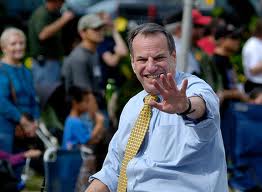
In the race’s first 10 months, Filner had made a habit of talking big on the trail. He had promised “the most aggressive campaign San Diego has ever seen,” an overflowing fundraising treasury and a waltz into the general election because he was the only Democrat in the race. Instead, he relied more on his past stances and broad ideology to win people over rather than a detailed vision of where he wanted to take San Diego. If DeMaio’s yard signs told the story of his campaign, Filner’s did, too. Filner didn’t buy many of his own. Instead, they read, “paid for by labor” at the bottom.
Immediately after Fletcher’s move, Filner’s campaign continued its downward trajectory. Filner was so lost on education policy at a debate that Fletcher had to explain a school reform law to him. Filner topped off his flubs over his major Unified Port of San Diego expansion plan when his cell phone rang in the middle of a television interview about it.
But soon Filner began receiving serious assistance fron an unlikely source. As far back as the winter, DeMaio would walk up to Filner at events and deliver a message, according to Filner’s campaign. “I’m reminding people that Bob Filner is the Democrat,” DeMaio would say.
DeMaio’s strategy was simple. A runoff against Filner would produce the kid of right vs. left battle that the councilman could win. A runoff against a moderate would be much tougher. And DeMaio had the money, campaign infrastructure and standing near the top of the polls to try to pick his opponent.
Once Fletcher started surging, it meant DeMaio and his supporters had to take out the assemblyman. When the campaign entered its final month, they began executing a plan relentlessly.
Voters’ mailboxes overflowed with mail from DeMaio attacking Fletcher’s poor attendance record in the Assembly. And the television airwaves showed an ad blasting the assemblyman for engineering a middle-of-the-night deal to send billions in tax revenues Downtown at the expense of state school funding.
DeMaio’s supporters believed these hits would work. Polling done by a political action committee backing DeMaio showed that 81 percent and 74 percent of Fletcher supporters were less likely to vote for the assemblyman once their heard about his abswenteeism and the Downtown dea, respectively. DeMaio also went so far as to send mail to Democrats, quoting left-wing politicians and using left-wing rhetoric to blast Fletcher’s standing with liberals.
Filner realized he benefited from all this, calling DeMaio his “best weapon” against Fletcher. He also began hitting a stride of his own. His debate appearances became sharper and crisper. He brought down Lt. Gov. Gavin Newsom, a stae Democratic heavyweight, for a fundraiser. And he spoke more humbly abougt his own campaign. He admitted that he should have spent more time raising money and that he had underestimated Fletcher.
It became impossible to pay even the slightest attention to the campaign and not hear the Filner-as-Democrat message.
Lost in all this drama was Dumanis. The 60-yeear-old district attorney entered the race as one of the favorites. She had cultivated powerful political relationships, and endorsement from the popular Sanders and a well-known law-and-order reputation with voters. But her problems began from the start.
Dumanis’ most powerful message, her experience and steady hand, took a hit early on when she fired her first campaign manager, reported lackluster fundraising totals and flip-flopped on Proposition B. Fletcher’s endorsement by the city’s police union and other public safety groups made it so that she couldn’t claim to be law enforcement’s choice for the job. And she struggled to communicate a simple vision for what she wanted San Diego to be under her leadership.
She tried to make San Diego’s flagging K-12 public education system her signature policy platform, even though the city has no control over schools. Dumanis succeeded in making education a campaign issue, but again couldn’t sell her ideas enough to make it a dominant one. Once Fletcher’s independence play succeeded, her efforts to capture the traditional San Diego middle fell short. Time and again, Fletcher supporters implored her to quit the race.
But Dumanis didn’t go out without a fight. She showed feistiness in the campaign’s last few weeks that cut against Fletcher and Filner and put them on the defensive.
Fletcher Fights Back, But It’s Not Enough
Meanwhile, Fletcher was struggling under th weight of all the attacks. Despite his fundraising prowess, Fletcher didn’t have enough money to chase the growing number of mail-in voters, maintain a consistent presence on television and organize a get-out-the-vote drive on Election Day. Besides, while Fletcher’s independence move was a stunning success at the time, it happened 10 weeks before Election Day. Fletcher didn’t have a second act, something other campaigns noticed.
“How does John DeLorean really follow up the DeLorean with anything else?” said Ron Nehring, a Dumanis consultant. “You have a really cool car, but then what do you do next?”
Fletcher turned his attention to Election Day. The campaign targeted people who typically don’t turn out in force for primaries: voters under 50, decline-to-states and moderates from both parties.
The election’s initial results showed Fletcher five points behind Filner. And Filner’s lead inched forward throughout the night.
But the election wasn’t about the middle or any one candidate who tried to court moderate support. Instead, the rules of a low-turnout primary held strong. Enough Republicans went Republican. Enough Democrats went Democratic. Everyone else didn’t vote.
“You do everything you can to ward off gravity,” said Jennifer Tierney, a Dumanis consultant. “But eventually, everything always hits the ground.”


